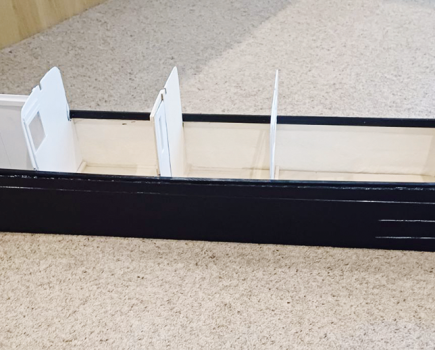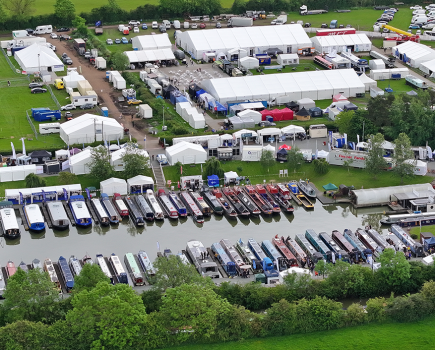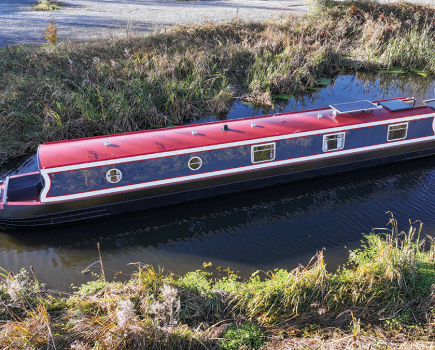When Shaun Wall decided to tackle a river challenge in a Springer, there was always time to plant his spriner in the mud and put the kettle on for a brew…

Among many adventures undertaken by Pentargon during her seven-year English odyssey, one was to take tides down estuaries and use waterflow to haul her bulk up unsuspecting rivers, going with the flow and – sometimes – against the odds. The serious side of this game began with an initial visit to Dartford during the spring of 2015, which involved going down the Thames to Crayford Ness and blundering up Dartford Creek to a safe haven and stay over. In an article on the potential of Dartford Creek, for the August 2018 issue of Canal Boat referencing the 2018 Dartford Nautical Festival, Martin Ludgate reported that “a first waterborne visitor, narrowboat Pentargon Springer, was followed by others”. For some time I’ve wondered whether Canal Boat readers might find the real story interesting.
Incidentally, Pentargon missed the 2018 Dartford Nautical Festival. As it got under way, she was ‘resting’ 50 miles upstream in Nauticalia’s yard at Shepperton. She had recently completed her greatest adventure of all: what is believed to be the biggest British Waterways ring ever completed solo and which just might be chronicled here at a future date. In June 2017, Pentargon was clocked on the Staff & Worcs at Gailey Wharf being modified by Jamie Ferguson to comply with Class D inland waterways use.

All of the tidal Thames between Teddington and Gravesend or further is Class C and, unbelievably, all of the Bristol Channel inside Portishead is also! In August 2017, Pentargon would take the tide from Sharpness to Bristol using the Dartford Technique, solo and overnighting on the tide outside Portishead.
Dartford volunteers had excavated an old mooring bollard on the quayside from beneath 40 years of neglect to provide purchase for Pentargon’s lines prior to her first visit: the first boat in more than 40 years known to overnight there.
Pentargon tied up alongside at 5.30pm on 26 April 2015, after considerable pre-planning and surveying earlier in the year as the attached piccies affirm. The IWA, great credit to them, had previously taken boats up the creek, scurrying back to the River while they still had water under their keels.

There was no evidence at all that anyone had gone up the Crayford Arm and certainly no admission that anyone had ever stayed over, as Pentargon did many times on a number of visits in 2015.
There are rumours that St Pancras Cruising Club members visited Crayford for a look but from landside and the famous ‘Tuesday Night Club’ had visited the Dartford arm.
Conrad Broadley brought his sloop up Old Crayford Basin in 2016, constrained by draught. He did overnight though, but had to leave on a 4.30am tide, the morrow morn.

Outside of the Dartford group, almost no one knew that Pentargon made multiple visits to the Creeks in 2015 and 2016 and stayed over for weeks at a time.
Her skipper did extensive surveying, depth-sounding and learned how the tide interacts with the river. He had pitched up on various berms in Dartford Creek and explored Crayford Creek in all weathers and tides to see what could and could not be done with a 36ft narrowboat in uncharted waters. The time is ripe to out that ‘lunatic’ skipper, once known as Pogue O’Déise or Pogue Muhone and recently retired from active seamanship.
I was born by a tidal estuary (The Colligan at Dungarvan), grew up by another, (Rogerstown in Fingal), sailing boats from childhood and learning the ways and wiles of tidal estuaries over decades. I had crossed the Shannon Estuary by descending the Ratty River from Bunratty and proceeded to the further shore and back on a blow-up inflatable! Turn of the century, I came to live by the Thames estuary, learned from old rivermen, lightermen, ferry skippers, amassed an enormous amount of practical hydrometry from assorted old codgers on many trips up and down the estuary as a volunteer stoker on the sail-trainer Kenya Jacaranda and as a volunteer with the London unit of the Maritime Volunteer Service. I learned the whole tidal Thames from Teddington to Southend. Those old men showed me tricks that have yet to appear on the web or even in books. Getting my own boat in 2012, I realised its potential as an Estuary Explorer. Pentargon was an unusual build as narrow-boats go and detailed probing brought to light that she had been constructed using ship-building techniques by Sam Springer. I owned a narrowboat which could go down to the seas I’d come from. I duly registered her as a small ship and her unique features were exploited to the full in various ascents and descents of the tidal Thames from Teddington or Brentford to Limehouse or Bow using the tides to carry the boat hither and thither before venturing further downstream to where there be dragons.

The first descent to Dartford was done by exiting a very early Bow Lock at the top of a tide which flowed Pentargon out to sea without any fuss or bother.
Minimal science was used that day, but I carried a complement of three London narrowboat skippers who wanted to learn how it was done. Incidentally, that was one of only a handful of trips I have undertaken with anyone else on board. I had planned to arrive at the mouth of the Darent about 11am, which was duly done, with the Tilbury gauge reading about 3m and dropping away. I nosed the boat around Crayfordness, pointed it into the Darent and drove it aground in the channel, to await the flood. Having ‘planted’ Pentargon firmly in the mud, she weren’t going anywhere til the next flood. Tea’s up! Let’s brew.
The bed of the Darent is higher than the surface of the estuary so Pentargon would be going nowhere for the next three hours or more simply because it had been grounded. Once the tide returned, we would float up and, as the tide continued to rise, the back flow in the creek would push it upriver. Tickover provided the propellor with enough energy to provide steering. Bit by bit we proceeded upstream that afternoon, stopping and starting on repeated groundings as time and tide lofted us higher and further inland. About 4.30pm we came to our last grounding; just below Bob Dunn bridge is a massive shoal of Kentish mud. Once through that, the boat began to move forward with less and less stops until we were in sight of the lock and the quay and the welcome party on shore who could not understand what was taking us so long. Here, another mudbank caused by the lock itself and 40 years of neglect stopped us awhile. We got in to the quay about 5pm but could not breast the cill just yet. So we tied up in the lock and were warmly welcomed to Dartford by the Friends of Dartford and Crayford Creek fronted by Conrad Broadley.

Pentargon’s crew had had a long day, so they took off for the railway station and oystered their way back to London in time for tea. I waited for another hour or so and slipped over the cill as soon as my 24in draft allowed.
We were home and dry as it were. During the night I played with the lines as the night tide flowed and ebbed.

Tell us about the boats in your life and you could win £100
Write in or email to editor@canalboat.co.uk. Images must be at least 21cm high/wide
Image(s) provided by:
Archant







